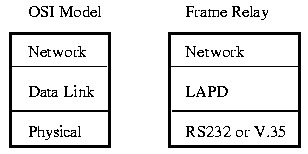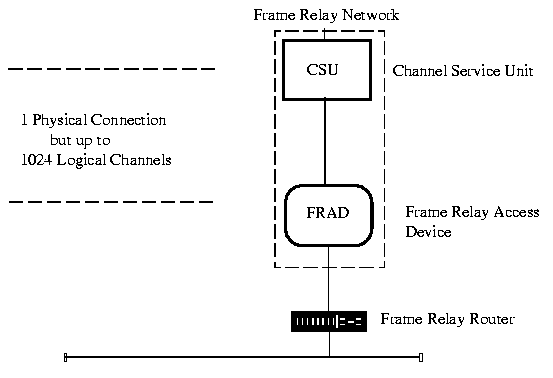| 63. Frame Relay | ||
|---|---|---|
|
|
Introduction to Data Communications | Next |
Packet Switching was developed as a method of multiplexing packets across the phone systems.
The term Bandwidth on Demand arises when using X.25 and Frame Relay. Both use packet switching which is a fancy way of saying that the packets are multiplexed on a common line. LAN traffic tends to be very bursty - periods of inactivity then large fast bursts of data. This is a very inefficient use of bandwidth if a large proportion of the time the line is idle. By using statistical multiplexing, bandwidth is used only when required hence the term Bandwidth on Demand.
Frame Relay is very similar to X.25. In fact Frame Relay was developed to improve on X.25's shortcomings: (slow speed and large overhead). Frame Relay was improved over X.25 by the following:

It uses the LAPD (Link Access Protocol D) for framing the packets. Higher layer protocols such as TCP/IP are encapsulated in the LAPD packet.

Frame Relay Frame
F - Flag HDR - Header DLCI - DL connection C/R - Command Response EA - Extended Address CF - Congestion Forward Notification CB - Congestion Backward Notification DE - Discard Eligibility bit CRC - Cyclic Redundancy Check
Frame Relay drops error checking at each node and relies on the upper layers such as TCP/IP to perform error checking. If a CRC (bit level error checking) error is found the packet is dropped. It is up to the Network layer to retransmit the packet. The assumption is that the Public Network is reliable enough to allow this.

Digital Switching
Frame Relay is made to interface with T1 (1.544 Mbps) and E1 (2.048 Mbps) digital switching lines. This results in a higher transfer speed and a much more reliable connection. This reliability allows Frame Relay to drop some of the error checking from the Data Link and Physical layers and rely on the Network Layer.
Increased Bandwidth
Frame Relay can presently operate up to 2.048 Mbps (E1) but there has been successful testing to 155 Mbps. Due to the low overhead, a Frame Relay network will be more efficient at sending data than an X.25 network. This means that more data will be transferred for the same amount of bytes.

| Introduction to Data Communications | ||
|---|---|---|
|
|
Table of Contents | Next |